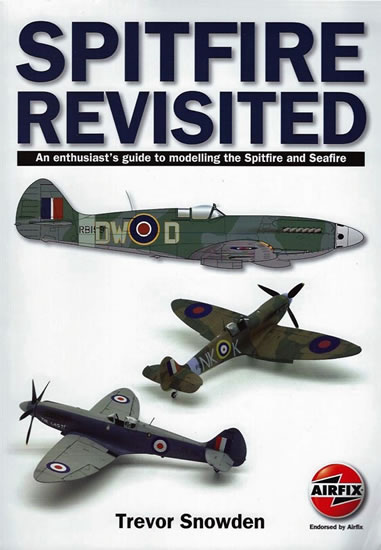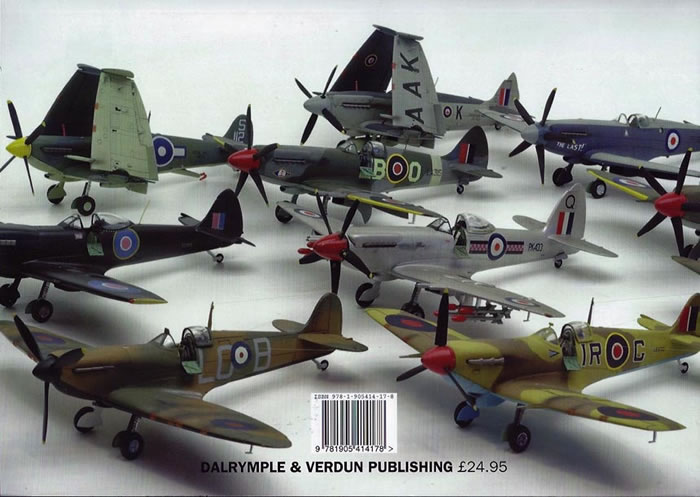Spitfire Revisited
An enthusiast’s guide to
modelleling the Spitfire and Seafire

by Trevor Snowden
Dalrymple & Verdun Publishing
S u m m a r y |
Publication Details: |
Spitfire Revisited
An enthusiast’s guide to modelleling the Spitfire and Seafire
by Trevor Snowden
Dalrymple & Verdun Publishing
|
| ISBN: |
978-1-905414-17-8 |
Media and Contents: |
Soft cover; approx. 8.5 in. x 11.5 in. / 21cm x 30cm; 144 pages plus covers, 37 colour profiles, 32 four-view colour illustrations, two-sided gatefold. |
Price: |
Price including postage: Within the UK - £24.95, Europe - £30.00, Rest of World - £33.00b y PayPal from Dalrymple & Verdun |
Review Type: |
FirstRead |
Advantages: |
Excellent introduction to all Marks of the Spitfire and Seafire. Great source of both information and inspirationDangerous to your pocketbook. |
Disadvantages: |
May cause modellers to spend more money on more Spitfire and Seafire kits. Also, it may not be the best on the fine points of the aircraft. |
Conclusion: |
This is the monograph for which anyone and everyone who is interested in the Spitfire and Seafire has been looking. |
Reviewed by Steven Eisenman

HyperScale is proudly supported by Squadron
If ever there was something that was flying under the radar, this monograph certainly is it. It appears to have been out for about a year or so. I received a copy for review, along with several other monographs, which may not have been high on many reviewers’ to do list.
I did a quick search for reviews and came up with virtually nothing. I did find some references to it in some discussion forums / fora. One poster used the word “excellent”, which about sums it up.
I just cannot fathom how, with all the new Spitfire and Seafire model kit releases that have come from Tamiya, Eduard and Airfix, this monograph has been so overlooked.

I would also like to qualify this review by saying that I am not a full-fledged “Spitfire Boffin”. So my observations about this monograph may miss details that a true “Boffin” would pick up.
Given that this monograph is only 144 pages and contains many pages of profiles, four-views and pictures of models, Mr. Snowden has taken on quite a task in presenting an overview of the birth and development of the Spitfire and Seafire.
For the Spitfire, the author begins with the prototype and continues through the Mk 24, and that includes PR and FR Marks. There is even a small section of the Speed Spitfire. For the Seafire, he takes us from Seafire I to the Seafire 47. Along the way, he does take the time to explain the reason for the shift from Roman to Arabic numerals, and why certain old practices are continued. This clarification is also undertaken with regard to the Rolls-Royce engines.
While perhaps not a Spitfire bible, it reads like a bible at time. We learn that one Mark begat another, tracing the lineage of each Mark. He also explains why the numerical sequence of the Marks is often out of order, as why the stopgap IX preceded the VII and VIII.

We are also made aware of production difference between Spitfires made by Vickers-Armstrong (parent of Supermarine) and those made by Morris Motors at Castle Bromwhich.
The author continues his story of both the Spitfire and Seafire by weaving together a mixture of aircraft development, changes and operational use. The problem here is that while comprehensive, it may not satisfy the more knowledgeable, and exacting, Boffin. For example, while he mentions that the intake under the cowl and elevators changed with the later Mk. IXs, there are no serial numbers or other reference points given. Drawings of difference are also lacking. So modellers using this reference are on their own in determining whether a particular Mk. IX had the changes.
But is this lack of specificity the Achilles heel of the monograph? I do not think so. The book is clearly intended as an introduction to the aircraft, and directed at the modeller. It does not represent itself as the ultimate monograph on the aircraft. And clearly, it is not the “Spitfire Bible”. At base, it is an excellent introduction to the Spitfire and Seafire, and an encouragement to the modeller to seek further information.
Since it is directed at the modeller, the monograph is filled with excellent color profiles and color four-view drawings. Each profile and four-view is given a detailed caption. The caption will set out, among other items, information about the Mark, the color scheme, markings and the aircraft’s combat service, and so forth.
The monograph also contains a goodly number of pictures of models of nearly all the Spitfires and Seafires that are covered. Even though this monograph is “endorsed by Airfix” (whatever that means), the models come from all manufactures. The only restriction imposed by the author was that they be 1/48 scale. The author, Neil Robinson and others made the models.
Among the models presented are a number of conversions and cross-kitting. The problem here is that only the most basic of information is given. For example, in creating a Mk. XIV, the Academy Mk. XIV tail unit was attached to the Airfix Mk. 22/24 fuselage. While the cut point is noted, the appropriate wings and propeller to be used are not mentioned. One would presume that the Academy wings and prop were used, but this is not mentioned nor are issues of fit discussed. There is also a suggested cross-kitting of the old Airfix Vb and the old Airfix Bf109F to get the captured Spitfire with the DB 605 engine.
One will also find “mistakes” in some of the models, mostly with regard to the paint scheme. Some are acknowledged. Still trying to find a reference for the yellow leading edge on the SEAC scheme Mk. VIII. Oh well. If nothing else, the models will provide a good bit of inspiration.
Finally there is a significant gate-fold / fold-out at the back of the monograph. It is a massive grid arrangement that sets out which parts are attributed to which model (i.e. a Mk. 11a vs. a Mk. IIb) and which parts apply to a Mark. It can be a little confusing, and skips over the detail and explanation.
At this point I am sure you are asking yourself whether this monograph is worth the price. And yes, it is a bit pricey, especially if you live outside of Europe. I am also sure every fan of the Spitfire and Seafire has his or her favorite reference book, many of which may be out of print.
But I don’t believe any of other monograph gives as organized and as comprehensive (though lacking in detailed specifics) and as readable an introduction to those aircraft as this monograph does. For any one starting out, this monograph is probably the best place to begin.
In addition, the monograph would be an inspiration to model the Spitfire and Seafire as it is filled with fine artwork and very nice models.
Thanks to Dalrymple & Verdun to for the review sample.
Review Copyright 2014 by Steven Eisenman
This Page Created on 17 January, 2014
Last updated
17 January, 2014
Back to HyperScale Main Page
Back to Reviews Page

|
